 Internet Explorer 6; will this thing ever die?! Now 9 years old – and superseded for almost half that time – it remains the bane of web developers’ lives the world over. Even YouTube and Google have jumped on the anti-IE6 bandwagon but the browser people love to hate remains the cockroach of the nuclear fallout that is standards-compliant ire.
Internet Explorer 6; will this thing ever die?! Now 9 years old – and superseded for almost half that time – it remains the bane of web developers’ lives the world over. Even YouTube and Google have jumped on the anti-IE6 bandwagon but the browser people love to hate remains the cockroach of the nuclear fallout that is standards-compliant ire.
There have been glimpses of hope and reports of it waning into obscurity but these appear to have been lies, damned lies, and statistics, at least in my corner of the world - Asia. Last week Webdesigner Depot told the story as it really is with a great post titled Will the Real Browser Stats Please Stand Up?
The post drew a series of data from StatCounter which showed that although IE6 was taking its last gasp in the US and Europe, it still had plenty of life left in it in Asia and was positively the picture of good health in China, the most populous - and one of the fastest growing - nations in the world.
How can this be? How, in the information super-age where everyone is interconnected and browser software flows freely, can a region with half the world’s population be so far behind? Because thar be pirates!
Hypothesis
 The Webdesigner Depot post was a great read, but it left a pretty fundamental question unanswered. Asian countries have a higher prevalence of IE6, that alone is an interesting observation, but the real intrigue is in why this is the case. When I started looking through the list of countries in the article, I couldn’t help but feel these resonated with the same names that continually pop up in the context of pirated software. One comment in the post touches on this theory but I wanted to delve a bit deeper.
The Webdesigner Depot post was a great read, but it left a pretty fundamental question unanswered. Asian countries have a higher prevalence of IE6, that alone is an interesting observation, but the real intrigue is in why this is the case. When I started looking through the list of countries in the article, I couldn’t help but feel these resonated with the same names that continually pop up in the context of pirated software. One comment in the post touches on this theory but I wanted to delve a bit deeper.
Has software piracy lead to a stay of execution for IE6? If so, how has this come about? And why is it so prevalent in Asia? It turns out the answers are not too hard to find.
The IE6 figures
First of all, the figures I’ll draw on are aggregates from the last 3 months and they all come from StatCounter. Now I know any numbers collected from request headers can be a bit erratic. After all, they’re manipulable andparticularly when you consider malicious software making HTTP requests, they can be quite unreliable. Still, it’s all we’ve got so let’s move forward.
Here’s the current state of 14 predominant Asian nations and the proportion of browsers identified as IE6. I’ve thrown in the USA, UK and Australia just for the sake of comparison with other corners of the world:
| IE6 | |
| Indonesia | 2.91% |
| | |
| USA | 4.44% |
| UK | 4.66% |
| Australia | 4.78% |
| | |
| Philippines | 4.86% |
| Singapore | 6.72% |
| Malaysia | 7.68% |
| Japan | 8.13% |
| Hong Kong | 14.77% |
| Bangladesh | 17.48% |
| Vietnam | 21.05% |
| Thailand | 21.54% |
| Pakistan | 23.49% |
| India | 24.10% |
| Taiwan | 32.70% |
| South Korea | 38.50% |
| China | 58.24% |
A few things here; firstly what’s going on with Indonesia?! It’s well and truly the outlier here. The Philippines also, is very low compared to the other nations. Fortunately, there’s a rational explanation which will expose itself shortly.
Secondly, although spread across three different continents, the western nations are very closely aligned. Of course they’re all culturally very similar so perhaps browser behaviour follows local customs?
Finally, the remaining countries fall into several very clear groups. Philippines through Japan are all very close to the non-Asian countries, Hong Kong through India fit into that “Asia average” range (for the record, the Asia average is 19.79%) then Taiwan through to China are right out there, the latter in particular.
The IE figures
One statistic that starts to clarify the previous results is the overall IE adoption which encompasses IE6, IE7 and IE8 (I haven’t seen anything earlier in any of the stats):
| IE6 | IE | |
| Indonesia | 2.91% | 7.73% |
| | ||
| USA | 4.44% | 52.75% |
| UK | 4.66% | 54.73% |
| Australia | 4.78% | 50.85% |
| | ||
| Philippines | 4.86% | 20.36% |
| Singapore | 6.72% | 51.97% |
| Malaysia | 7.68% | 42.34% |
| Japan | 8.13% | 61.09% |
| Hong Kong | 14.77% | 67.88% |
| Bangladesh | 17.48% | 32.10% |
| Vietnam | 21.05% | 55.34% |
| Thailand | 21.54% | 78.13% |
| Pakistan | 23.49% | 50.32% |
| India | 24.10% | 48.41% |
| Taiwan | 32.70% | 84.00% |
| South Korea | 38.50% | 94.08% |
| China | 58.24% | 89.04% |
So the deal with Indonesia is that nobody uses IE. Ok, not quite “nobody” but the figure is amazingly low. So what on earth is everyone using? Firefox, as it turns out:
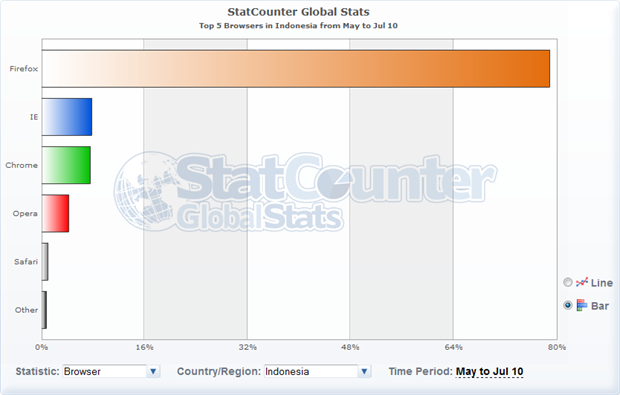
The figures seem so Firefox favourable, they almost seem wrong. Still, the Spread Firefox website was reporting 63% market share in July last year. Even this seems very high for a browser not packaged with the OS and only available if users consciously seek it out. But have a look at a line chart over time, starting with July 09:
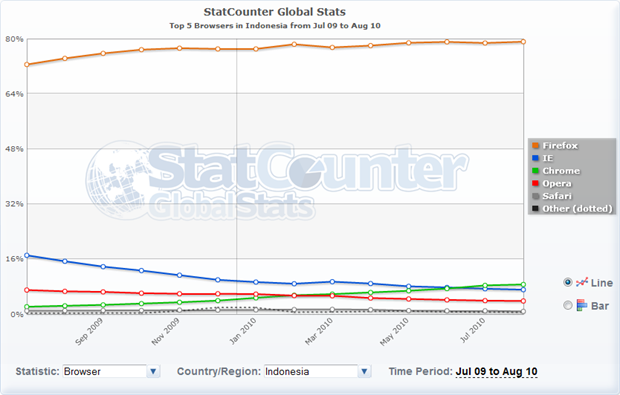
Firefox absolutely dominates with all the others fading into obscurity. The bottom line is this: IE stats for Indonesia represent an extremely small portion of browsers – hence why they’re an outlier in the previous table - so let’s not pay too much attention to them in terms of the pirate hypothesis.
The Philippines is a similar deal. Even though they have several times the IE market share that Indonesia does, it’s still less than half that of every other country, the western ones included. Furthermore, according to StatCounter it’s had a steady decline with Firefox remaining dominant and Chrome rising at a rapid rate:
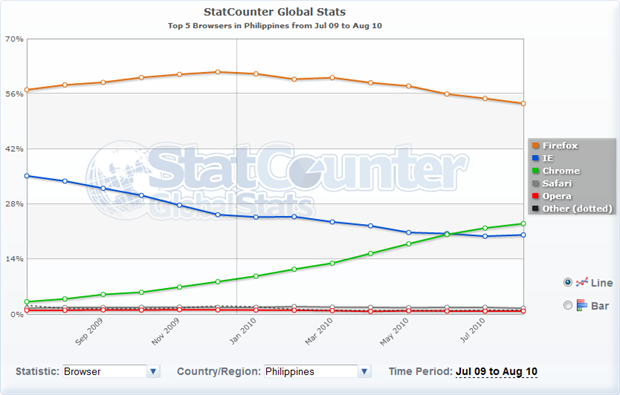
So the Philippines is also a bit of an exception. Once we take both these countries out of the equation we’re left with a clear pattern (albeit with a couple of bumps). The greater the IE adoption, the greater the proportion of users who remain stuck on IE6:
| IE6 | IE | |
| USA | 4.44% | 52.75% |
| UK | 4.66% | 54.73% |
| Australia | 4.78% | 50.85% |
| | ||
| Singapore | 6.72% | 51.97% |
| Malaysia | 7.68% | 42.34% |
| Japan | 8.13% | 61.09% |
| Hong Kong | 14.77% | 67.88% |
| Bangladesh | 17.48% | 32.10% |
| Vietnam | 21.05% | 55.34% |
| Thailand | 21.54% | 78.13% |
| Pakistan | 23.49% | 50.32% |
| India | 24.10% | 48.41% |
| Taiwan | 32.70% | 84.00% |
| South Korea | 38.50% | 94.08% |
| China | 58.24% | 89.04% |
The operating system figures
The correlation between browser adoption and version retention is interesting, but it doesn’t make the pirate link. To do this we need to look at operating systems and particular, at Windows XP:
| IE6 | IE | XP | |
| USA | 4.44% | 52.75% | 41.11% |
| UK | 4.66% | 54.73% | 39.62% |
| Australia | 4.78% | 50.85% | 43.01% |
| | |||
| Singapore | 6.72% | 51.97% | 43.82% |
| Malaysia | 7.68% | 42.34% | 58.32% |
| Japan | 8.13% | 61.09% | 49.24% |
| Hong Kong | 14.77% | 67.88% | 60.84% |
| Bangladesh | 17.48% | 32.10% | 79.68% |
| Vietnam | 21.05% | 55.34% | 81.91% |
| Thailand | 21.54% | 78.13% | 85.23% |
| Pakistan | 23.49% | 50.32% | 83.26% |
| India | 24.10% | 48.41% | 77.08% |
| Taiwan | 32.70% | 84.00% | 77.28% |
| South Korea | 38.50% | 94.08% | 75.34% |
| China | 58.24% | 89.04% | 87.69% |
This is a really stark correlation; there is a very consistent link between running the IE6 browser and using Windows XP. The question though, is why this would be when XP can happily run IE7 or IE8. Furthermore, Windows XP has Windows Update which Microsoft currently uses to push IE8 out to all Windows XP installations:
Starting on or about the third week of April [2009], users still running IE6 or IE7 on Windows XP, Windows Vista, Windows Server 2003, or Windows Server 2008 will get will get a notification through Automatic Update about IE8.
So what would stop Windows XP users from getting new versions of IE pushed to them by Windows Update? Simple – Windows Genuine Advantage.
The Windows Genuine Advantage problem
Microsoft released Windows Genuine Advantage (WGA) back in 2006 as a means of combating piracy of its operating system. As a result, users of non-genuine copies cannot run Windows Update:
The company has made installation of Windows Genuine Advantage a requirement for use of the Windows Update and Microsoft Update websites
This is where the penny starts to drop; if you run a pirated version of Windows, you cannot receive IE through the most common channel by which it’s distributed, Windows Update. Now we have a possible explanation for why people aren’t upgrading, but a little more evidence would be nice.
Pirates ahoy – where the safe harbours are
NationMaster.com has a bunch of really interesting crime statistics including software piracy rates by country which reports on the following:
The piracy rate is the total number of units of pirated software deployed in 2007 divided by the total units of software installed.
If we take these for the 12 Asian countries we have remaining in our stats (and throw in the three western ones for comparison sake), we do see some correlation. Keep in mind though that these figures are from three years ago whereas the browser and OS stats are present day (which could explain a couple of the non-correlating rows):
| IE6 | IE | XP | Piracy | |
| USA | 4.44% | 52.75% | 41.11% | 20% |
| UK | 4.66% | 54.73% | 39.62% | 26% |
| Australia | 4.78% | 50.85% | 43.01% | 28% |
| | ||||
| Singapore | 6.72% | 51.97% | 43.82% | 37% |
| Malaysia | 7.68% | 42.34% | 58.32% | 59% |
| Japan | 8.13% | 61.09% | 49.24% | 23% |
| Hong Kong | 14.77% | 67.88% | 60.84% | 51% |
| Bangladesh | 17.48% | 32.10% | 79.68% | 92% |
| Vietnam | 21.05% | 55.34% | 81.91% | 85% |
| Thailand | 21.54% | 78.13% | 85.23% | 78% |
| Pakistan | 23.49% | 50.32% | 83.26% | 84% |
| India | 24.10% | 48.41% | 77.08% | 69% |
| Taiwan | 32.70% | 84.00% | 77.28% | 40% |
| South Korea | 38.50% | 94.08% | 75.34% | 43% |
| China | 58.24% | 89.04% | 87.69% | 82% |
The link between IE6 and piracy rates is not quite as stark as it is with Windows XP, but there is a definite pattern there. Generally speaking, countries with higher rates of software piracy have a greater prevalence of Windows XP and IE6.
Behind the great firewall of China
Of all the Asian nations represented above, China is the one which features most heavily, most consistently. It has the highest percentage of IE6 users, the second highest rate of IE in general, the highest incidence of Windows XP and one of the highest rates of piracy. It also has the highest population, not just in Asia but worldwide. What happens in China, matters. Enormously.
China is an emerging market where everything happens quickly. Annual growth rates of many large corporations often exceed those achieved by their counterparts in the western world over a decade. That growth rate extends to the uptake of the internet, just take a look at how China compares to the other countries in terms of the number of internet users:
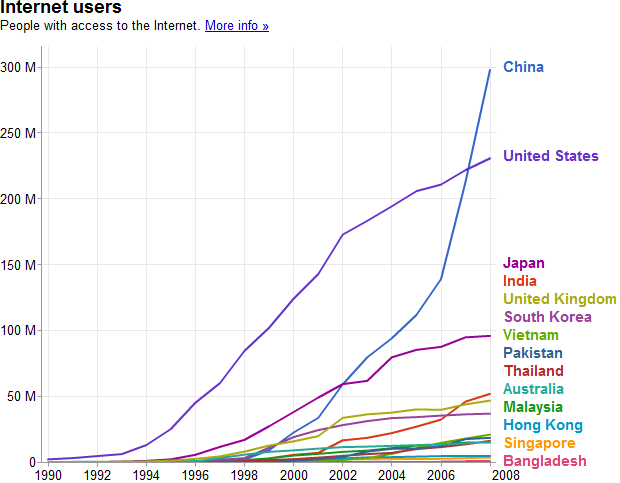
The rate of growth is stunning but what’s even more stunning is that these figures only go up to 2008 (the World Bank data source doesn’t go beyond this). More recent stats (June this year) are showing 420 million internet users – and that’s only 32% of the population!
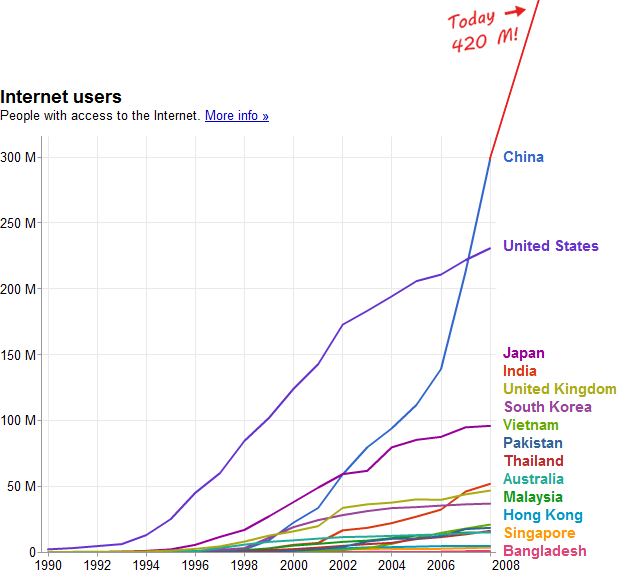
In the context of Asia, China has twice as many IE6 users as the other 11 countries we’ve been looking at combined! They’re not solely responsible for the browser clinging on to dear life, they’re just mostly responsible.
So here’s a country with a rapidly increasing, huge number of internet users with a very high dependency on Windows XP and IE6 and a high rate of piracy making upgrading the browser more difficult. So far we’ve assumed a link between piracy and Windows XP, let’s do one more sanity check to validate this.
Inside the Tomato Garden
 Up until recently, there was a roaring trade in China for a Windows XP variant known as Tomato Garden. Actually, “variant” is probably not really a suitable term because Tomato Garden is actually a pirated version of Microsoft’s own operating system.
Up until recently, there was a roaring trade in China for a Windows XP variant known as Tomato Garden. Actually, “variant” is probably not really a suitable term because Tomato Garden is actually a pirated version of Microsoft’s own operating system.
According to reports, Tomato Garden was actively used by more than 90 percent of users in a recent survey. The same article also talks about how when the perpetrators were finally arrested (and later sentenced to jail), less than 5 percent of people actually supported Microsoft’s right for intellectual property protection. In short, pirated software is rife and everyone is pretty comfortable with it.
I’ll steer away from the legal and ethical implications of Tomato Garden because in the context of IE6, it’s not really relevant. What is relevant, however, is that this illustrates there has been a highly organised distribution of Windows XP – which has IE6 preinstalled - without the ability to automatically update it to newer versions.
The government and corporate sectors
Just one very brief comment on governments and corporates; some may argue IE6 remains so prevalent because these sectors have been very slow to upgrade. The UK government is a perfect example of this so certainly this argument is true to a degree.
However, the fact that the IE6 figure is such a small proportion of overall users in many countries plus the fact its prevalence increases in proportion to a nation’s penchant to pirate software is more than just coincidental. Add to that the IE upgrade limitations imposed on non-genuine copies of Windows and the pirate argument becomes pretty compelling.
Conclusions and future speculation
I think the most interesting thing of all about this hypothesis is that it shows the browser version landscape is complex. It’s not as simple as just taking Windows updates, if indeed IE is even being used to begin with. It also can’t be comprehensively tackled by western-centric organisations phasing out support for any single browser version. And it’s not just the corporations and governments languishing behind, although they certainly have to take some blame.
Will the IE status quo in Asia change any time soon? No, there’s simply too much dependency on pirated versions of Windows XP and it’s too ingrained into the local culture. Push factors such as YouTube dropping support of it have zero impact in China because the service is blocked by the great firewall of China anyway.
For web developers, the comments made back in the original article about the real browser stats standing up are very apt; know your audience. Understand the location of the target demographic and prepare web app compatibility accordingly. Do not rely on general demographic data because it varies so much across the globe.
If indeed this hypothesis is correct - and I think there’s a better than average chance it is – we’re going to need to get used to IE6 hanging around for years to come. That may not be an issue for many people but personally, Asia is just too important in the global landscape to ignore and for that reason alone, IE6 will continue to be towards the top of my compatibility list. After all, even pirates need browser compatible websites.